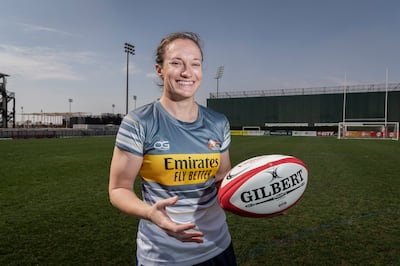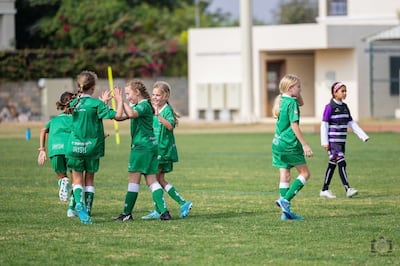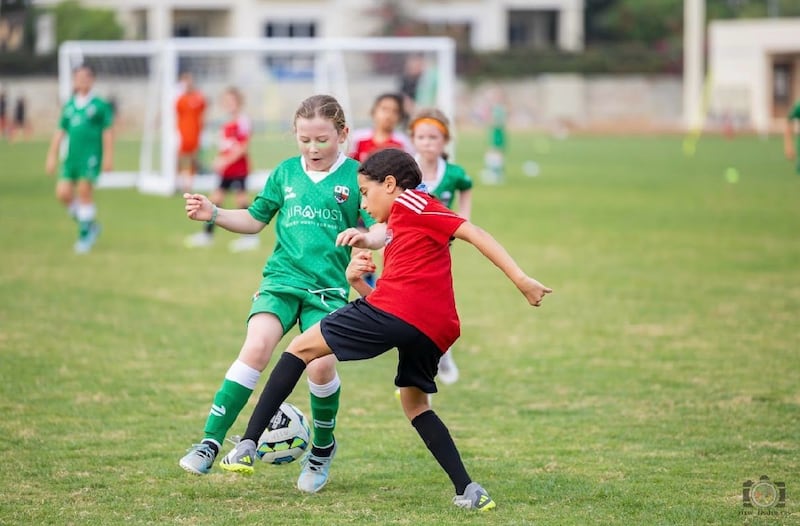Sports teams in Dubai are seeing an increase in young girls wanting to sign up to take part in rugby and football, which coaches attribute to a rise in inspirational female athletes.
They said they had also received significant interest in women's sports from teenagers thanks to wider access to complexes, coaches, dedicated girls-only teams, clubs and competitive leagues in the emirate.
Emirates Dubai 7s is one event to record a significant increase in interest.
Alongside rugby, the annual event staged each December now hosts five sports tournaments during the festival.
Since 2022, the number of females participating in its netball events increased by 23 per cent, while 21 per cent more signed up to play rugby.
In the ED7 multi-event fitness challenge – WODON3 – 43 per cent more girls and women signed up to take part last year than in 2022.
Role models
Alex Cook, 35, who works in the commercial department of ED7 and is also captain of Dubai Hurricanes rugby, said more female sporting role models have inspired younger children to take part.
“Women's rugby in particular is one of the fastest growing sports,” said Ms Cook, who is captain of the UAE Women's 7s team," she said.
“That can be down to quite a lot of reasons, such as all of the media attention that women's rugby is getting now.

“It has grown year on year of participation, which is fantastic. The sevens series now has 12 men's teams and 12 women's teams, so there is equal participation.
“That's just brilliant for sport because now people can see women playing rugby on TV. As a rugby player, I think the interest has always been there, but now people are actually taking notice.”
Global growth
According to World Rugby, female participation rose by 7 per cent last year to reach about two million.
In 12 months, the number of active registered female players rose about 34 per cent to 319,966 worldwide, with a 53 per cent increase in female participation overall.
Participation was measured through engagement programmes, such as those at primary schools or club level.
The number of top-level games also increased to 100 test matches last year, further increasing exposure to women’s sport.
“A lot of people I grew up playing rugby with are now people's idols or role models in sport,” said Ms Cook, who is from Calne, near the rugby hotbed of Bath, England.
“As a kid, you'd only look up to men because those were the only ones you would see. Now, young girls have women to look up to.”
Football in Dubai is also witnessing an increased interest among young girls.
In 2018, Dubai Irish FC had a vibrant under-18 programme, but the number of young boys playing regularly each week far outnumbered girls.
Since then, thanks in part to high-profile successes by the England Lionesses football team at recent World Cups and European Championships, the club now has a dedicated women’s division taking part in competitive matches.
“The girls' side of things has grown rapidly,” said Tony Christian, Dubai Irish Football Club chairman, a volunteer and quantity surveyor for Khansaheb Civil Engineering.
“We’ve created an environment where girls can come along and play, even if football isn't their first sport.
“Historically, football would have been perceived as a male sport. Now those shackles are being shaken off and girls are seeing football is as much for girls and can get involved.”
Pink Shamrocks
Female participation at the club has grown considerably from just six regular players in 2018 to 150 today.
That demand has led to a dedicated team for young girls called the Pink Shamrocks, who turn out against other women-only sides across Dubai.

Despite increased participation, the women’s game has reported a disproportionate number of knee injuries.
While kit suppliers are slowly beginning to make team strips specifically for women, most football boots are designed for men.
The disparity has been blamed as a contributing factor in the high number of anterior cruciate knee ligament (ACL) injuries in both the women’s game.
During last year's Women's World Cup in Australia and New Zealand, 30 top players were not called up due to ACL injuries.
Research found women are up to six times more likely to have an ACL injury than men, with experts saying landing patterns, running action, bone density and hormones all contribute to greater risk.
Despite the potential for knee injuries, Mr Christian said low club fees and a high number of volunteers are keeping participation rates high.
“We've seen a real resurgence because our fees are relatively low – it means girls can come along and just give it a try,” he said.
“My own daughter plays and she feels like she's not just part of the boys' team, as the girls have got their own squad, their own section of the club and their own identity.
“We've got more than 60 different nationalities playing with us and we've provided a comfortable environment for them to play in.
“This is probably the first season where we've got girls all playing in a weekly league. And that gives the girls something to aim for.”







